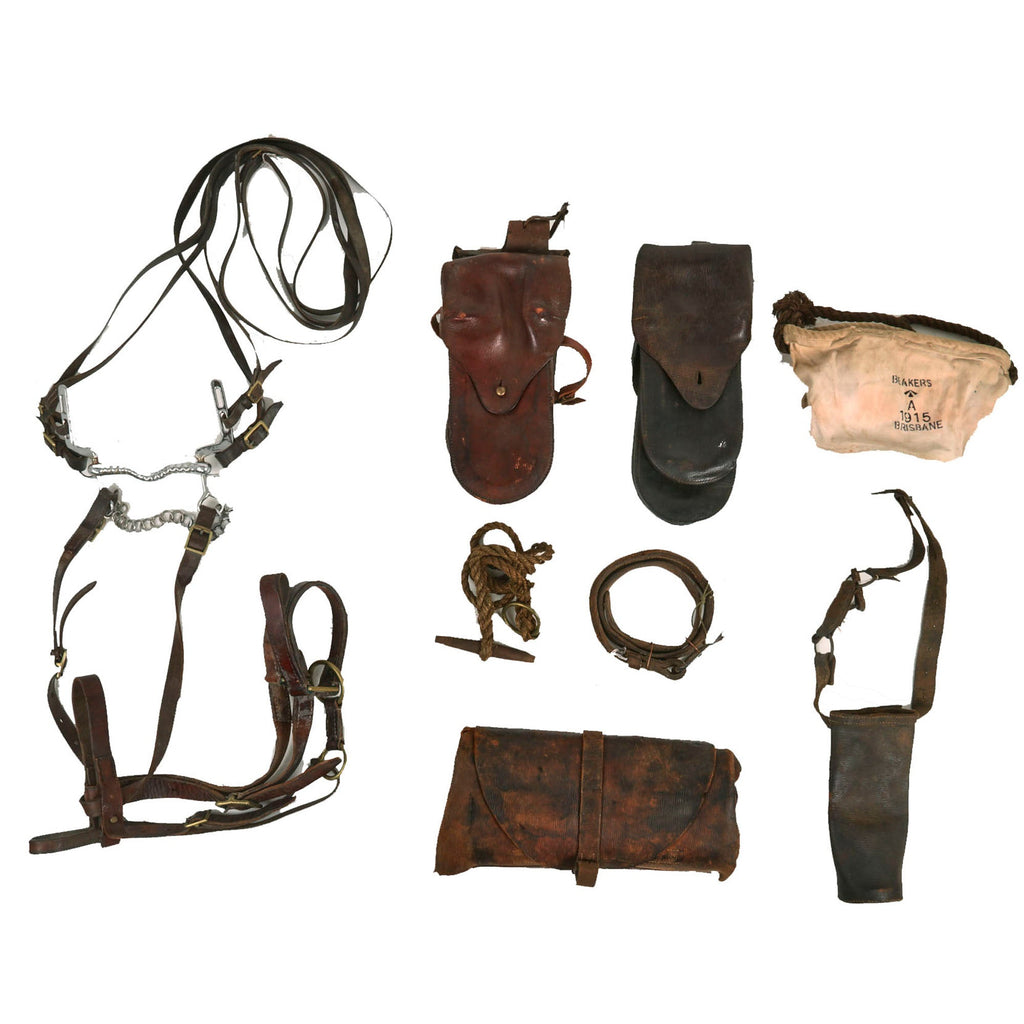Item Description
Original Items: Only One Set Available. The Australian War Memorial combines a shrine, a world-class museum, and an extensive archive. The Memorial's purpose is to commemorate the sacrifice of those Australians who have died in war or on operational service and those who have served our nation in times of conflict. Its mission is leading remembrance and understanding of Australia’s wartime experience.
There is no better place to receive items than from an incredible, well known museum! The set consists of two lovely standard issue brown leather officer’s “saddle wallets”. Wallets have adjustable stud fastenings and flaps lined with brown checked waterproof fabric. The linking strap has slit in leather and a short buckle and strap for attachment to the pommel of the saddle.
Other items include:
- 1915 Dated Canvas Water Bucket
- Tool Pouch
- Leather Tool Roll
- Harness and Bit
The leather components do have scattered markings though they are faint. You have to keep in mind that once these pieces of equipment were suspended from a saddle or the horse itself, they rubbed for countless miles making any markings that were once legible now difficult to read. The leather is still supple though there are a few areas, especially the straps that are more worn than the rest with scattered dry areas, popped stitches and slight tearing.
Before the introduction of treaded vehicles and tanks, the cavalry was the backbone of most militaries, offering a spearheaded attack into modern battles of the time. No collection is complete without early cavalry equipment!
Comes more than ready for further research and display.
Walers were the type of horse used by light horsemen in the campaign in the Middle East during the First World War. The light horse combined the mobility of cavalry with the fighting skills of infantry. They fought dismounted, with rifles and bayonets. However, sometimes they charged on horseback, notably at Magdhaba and Beersheba. The smallest unit of a light horse regiment was the four-man section: one holding the horses while the other three fought.
The horses were called Walers because, although they came from all parts of Australia, they were originally sold through New South Wales. They were sturdy, hardy horses, able to travel long distances in hot weather with little water.
Horses usually need to drink about 30 litres of water a day. However, during the campaign they often went for up to 60 hours without water, while carrying a load of almost 130 kilograms, comprising rider, saddle, equipment, food, and water.
At the end of the First World War Australians had 13,000 surplus horses which could not be returned home for quarantine reasons. Of these, 11,000 were sold, the majority as remounts for the British Army in India (as was the case with this horse) and two thousand were cast for age or infirmity.
Light horse were like mounted infantry in that they usually fought dismounted, using their horses as transport to the battlefield and as a means of swift disengagement when retreating or retiring. A famous exception to this rule though was the charge of the 4th and 12th Light Horse Regiments at Beersheba on 31 October 1917. In 1918, some light horse regiments were equipped with sabres, enabling them to fight in a conventional cavalry role in the advance on Damascus. However, unlike mounted infantry, the light horse also performed certain cavalry roles, such as scouting and screening, while mounted.
The light horse were organized along cavalry rather than infantry lines. A light horse regiment, although technically equivalent to an infantry battalion in terms of command level, contained only 25 officers and 400 men as opposed to an infantry battalion that consisted of around 1,000 men. Around a quarter of this nominal strength (or one man in each section of 4) could be allotted to horse-holding duties when the regiment entered combat.[5][4] A regiment was divided into three squadrons, designated "A", "B" and "C" (equivalent to a company), and a squadron divided into four troops (equivalent to but smaller than a platoon). Each troop was divided into about 10 four-man sections. When dismounting for combat, one man from each section would take the reins of the other three men's horses and lead them out of the firing line where he would remain until called upon.
Each regiment initially had a troop of two Maxim guns but during the Gallipoli Campaign, where the light horse served dismounted, this was increased to four guns. In 1916, following the establishment of the Australian Machine Gun Corps, these were consolidated into four light horse machine gun squadrons, each with 12 Vickers machine guns, allocated at brigade level within the 1st, 2nd, 3rd and 4th Light Horse Brigades.[6] In turn, the troops received the Lewis Gun. This was replaced by the Hotchkiss M1909 Benét–Mercié machine gun in April 1917. Eventually they arrived in such numbers as to allow each troop to have a Hotchkiss gun, which considerably added to the mobile firepower of a regiment.
The Australian Waler horse was the common mount for the light horsemen, as it was strong and hardy, which was needed in the harsh desert climate. This was facilitated by the horses being left behind in Egypt while the light horsemen went to Gallipoli, allowing them to gradually acclimatize.
Although the authorities did not welcome Indigenous men into the Australian Armed Forces, nonetheless some managed to enlist in the Australian Light Horse. Unlike in civilian life, where Indigenous men received a lower rate of pay, in the Army there was only one rate of pay. This may have been a motivation for their enlistment, in addition to other considerations, including patriotism. Several served during the Gallipoli campaign. Skilled in working with horses, and in hot climates, they were valued members of the Light Horse.
- This product is available for international shipping.
- Eligible for all payments - Visa, Mastercard, Discover, AMEX, Paypal & Sezzle





















